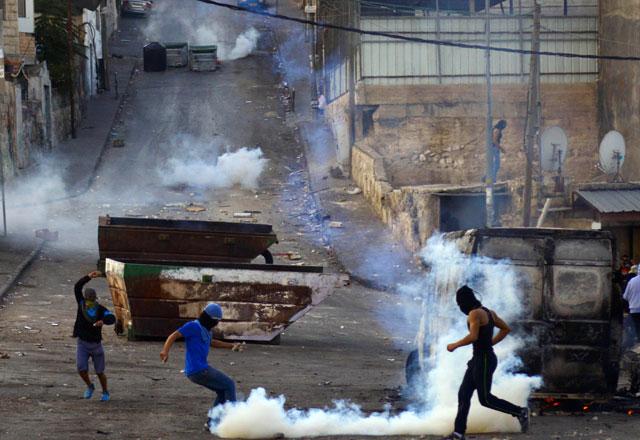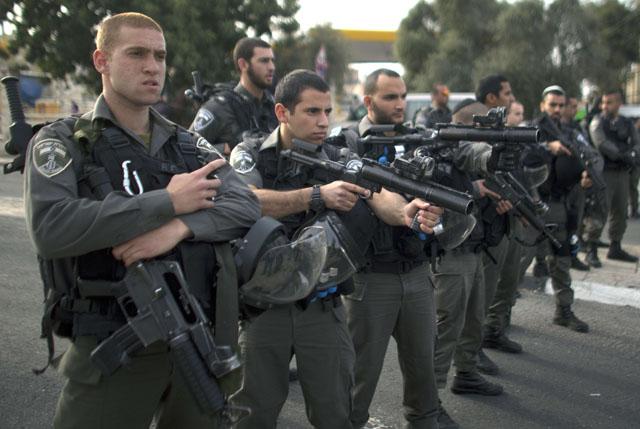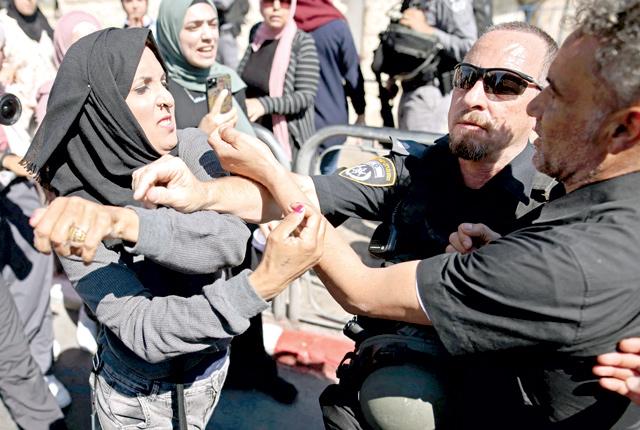You are here
Clashes erupt in Jerusalem after Israeli forces kill Palestinian
By Reuters - Oct 30,2014 - Last updated at Oct 30,2014

OCCUPIED JERUSALEM — Israeli forces on Thursday shot dead a 32-year-old Palestinian man suspected of having tried hours earlier to kill a far-right Jewish man, leading to fierce clashes in East Jerusalem.
Al Aqsa compound, known to Muslims as Al Haram Al Sharif, a holy site at the heart of the latest violence, was shut down for almost an entire day to all visitors "as a security precaution".
It was the first full closure of the site, venerated by both Jews and Muslims, in 14 years. Late on Thursday Israeli forces reopened the complex.
Palestinian President Mahmoud Abbas denounced Israel's actions as "tantamount to a declaration of war" and his Fateh Party called for a "day of rage" on Friday. It was not clear if Al Aqsa would be opened to Muslims on their holy day.
Moataz Hejazi's body lay in blood among satellite dishes and a solar panel on the rooftop of a three-storey house in Abu Tor, a district of Arab East Jerusalem, as Israeli forces sealed off the area and repelled Palestinian protesters.
Hejazi was suspected of shooting and wounding Yehuda Glick, a far-right religious leader who has led a campaign for Jews to be allowed to pray at Al Aqsa compound, known to Jews as the Temple Mount.
Glick, a US-born settler, was shot as he left a conference at the Menachem Begin Heritage Centre in Jerusalem late on Wednesday. His assailant escaped on the back of a motorcycle.
A spokesperson for the centre said Hejazi had worked at a restaurant there. Glick, 48, remains in serious but stable condition with four gunshot wounds, doctors said.
Residents said hundreds of Israeli security personnel were involved in the predawn search for Hejazi. He was tracked down to his family home in the hilly backstreets of Abu Tor and eventually cornered on the terrace of an adjacent building.
“Anti-terrorist police units surrounded a house in the Abu Tor neighbourhood to arrest a suspect in the attempted assassination of Yehuda Glick,” Israeli spokesperson Micky Rosenfeld said. “Immediately upon arrival they were shot at. They returned fire and shot and killed the suspect.”
Local residents identified the man as Hejazi, who was released from an Israeli prison in 2012 after serving 11 years. Israeli personnel fired stun grenades to keep back groups of angry residents as they watched from surrounding balconies.
Abu Tor residents said Hejazi was a good son from a respectable family.
“They are good people, he does nothing wrong,” said Niveen, a young woman who declined to give her family name.
East Jerusalem, which Israel occupied in the 1967 Middle East war, has been a source of intense friction in recent months, especially around Silwan, which sits in the shadow of the Old City and Al Aqsa.
Jewish settler organisations have acquired more than two dozen buildings in Silwan over the years, including nine in the past three months, and moved settler families into them, an effort to make the district more Jewish. Around 500 settlers now live among approximately 40,000 Palestinians residents.
The influx of settlers combined with tension over the site, Islam’s third-holiest shrine and the holiest place in Judaism, have contributed to the most fractious atmosphere in East Jerusalem since the second Intifada or uprising began in 2000.
The United States condemned the shooting of Glick but urged all sides to exercise restraint and maintain the “historic status quo” at the Jerusalem holy site.
On Thursday, crowds of young Palestinian men and boys blocked off streets near where Hejazi was killed with rubbish skips and lit fires. They smashed tiles and bricks and used the pieces to throw at Israeli forces.
The Israelis responded with tear gas, scattering the crowd. Clashes continued for hours after Hejazi was killed.
“It is not a good situation, it is the worst, everyone is angry,” said Galib Abu Nejmeh, 65, who wandered down the rock-strewn street.
“It is becoming like another Intifada,” he said, comparing it to the scenes in East Jerusalem in the late 1980s, when Palestinians first rose up against Israeli occupation.
After Glick was shot, far-right Jewish groups urged supporters to march on Al Aqsa on Thursday morning. That prompted Israeli forces to shut access to the site to everyone — Muslims, Jews and all tourists.
Glick and his backers, including Moshe Feiglin, a far-right member of Prime Minister Benjamin Netanyahu’s Likud Party, are determined to change the status quo that has governed Al Aqsa since Israel seized the walled Old City in 1967.
Those rules state that Jordan’s religious authorities are responsible for administering Al Aqsa complex and that while Jews may visit the marble-and-stone esplanade, which includes the 7th-century golden Dome of the Rock, they cannot pray there.
Glick and his supporters argue that Jews should have the right to pray at their holiest site, where two ancient Jewish temples once stood, even though the Israeli rabbinate says the Torah forbids it and many Jews consider it unacceptable.
Related Articles
Israeli occupation forces deployed heavily around Jerusalem's flashpoint Al Aqsa Mosque compound as it reopened Friday for Muslim prayers after a rare closure during clashes over the killing of a Palestinian by Israeli forces.
A far-right Israeli Cabinet minister on Sunday paid a brief visit to the flashpoint Al Aqsa Mosque compound in Jerusalem’s Old City, an Israeli security official said.
OCCUPIED JERUSALEM — Israeli forces blocked roads in Jerusalem on Tuesday as Jewish ultranationalists prepared to march through the city's o













